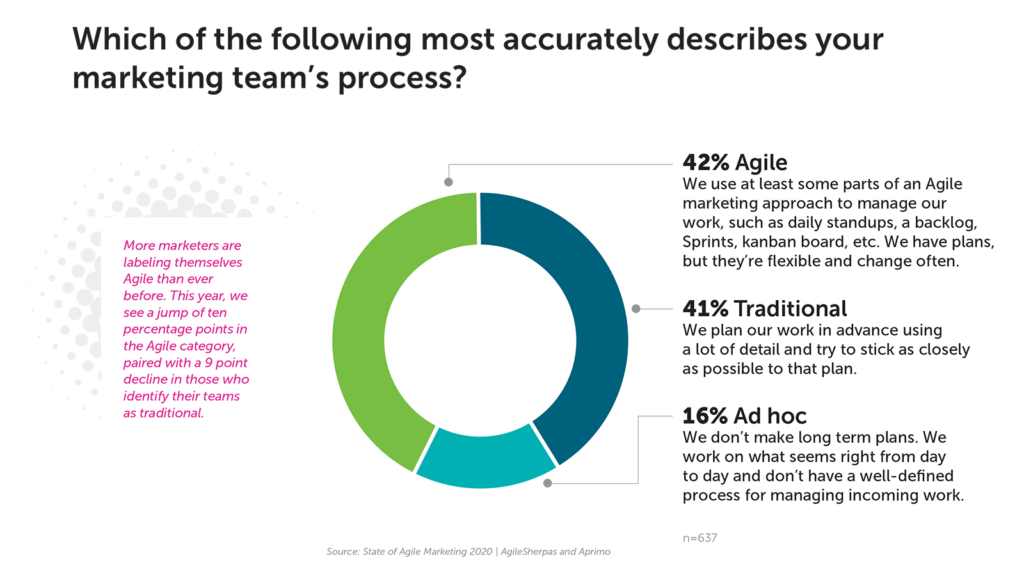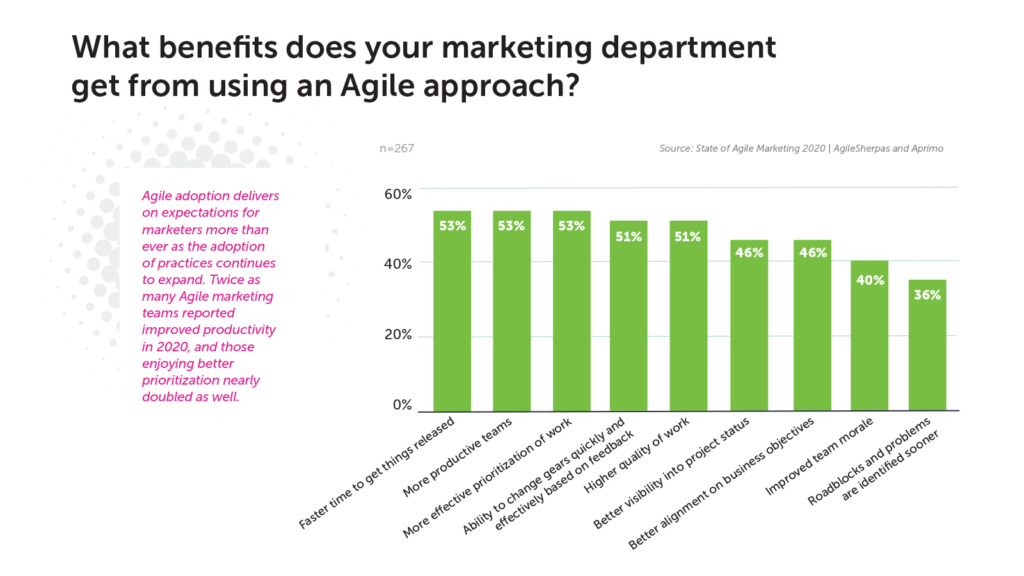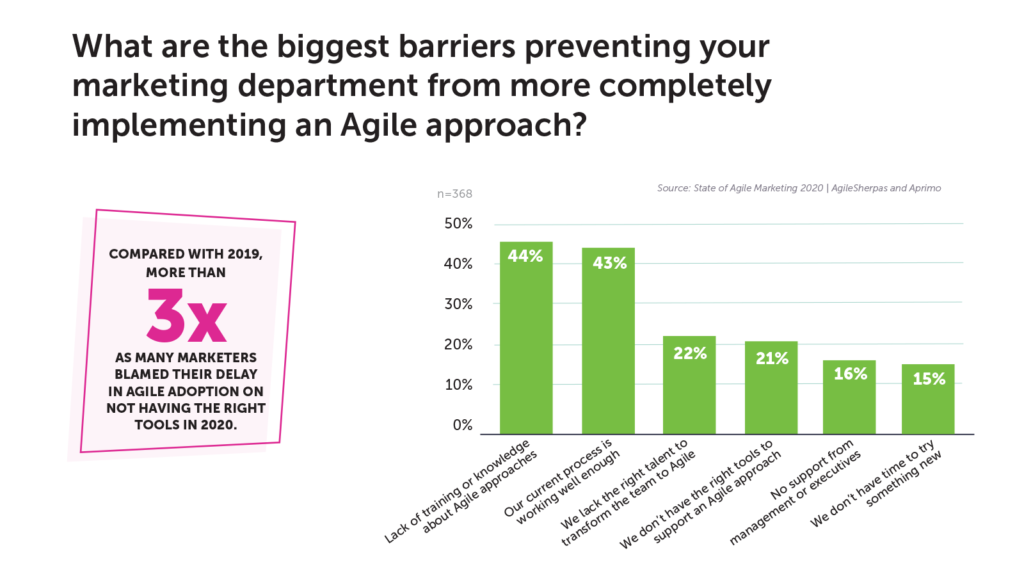 Each year, AgileSherpas surveys hundreds of marketers about the ins and outs of their agility (or lack thereof). This year, the collected data about Agile in marketing is compiled into the 3rd Annual State of Agile Marketing Report.
Each year, AgileSherpas surveys hundreds of marketers about the ins and outs of their agility (or lack thereof). This year, the collected data about Agile in marketing is compiled into the 3rd Annual State of Agile Marketing Report.
In previous editions of the report (you can find the 2019 edition here and 2018 edition here), we’ve observed marketing agility become increasingly popular among our respondents. More and more teams have also found that once they commit to Agile adoption, Agile manages to deliver on the benefits it promises.
Over the last few years, the trend for Agile in marketing has been positive. But, this year the results were particularly exceptional due to how marketers are reacting to the volatile circumstances they find themselves in.
Changing consumer behaviors, an emphasis on building departmental resilience, and, above all, the indisputable need to become highly adaptive have encouraged more marketing teams to seek the benefits of agility.
The report is definitive: Agile is (and will continue) making some seriously positive ripples in the marketing profession this year, but these benefits aren’t without their challenges. Here’s what’s going on inside the Agile marketing revolution, and what makes this year so important.
Agile Marketers Overtake Traditional Marketers
This year’s report marks a real milestone for the application of Agile methodology among marketers, and more generally, outside of IT departments.
For the first time in the history of the State of Agile Marketing Report, more marketers labeled themselves Agile than traditional or ad hoc. That makes Agile the most commonly cited approach among our respondents!
Whichever way you look at it — this is awesome news.
Traditional and ad hoc approaches to marketing work have been causing problems for marketing professionals and other knowledge workers for years (dare we say, decades). The trend toward Agile in marketing is a welcome shift for the 42% of the 600-plus marketers we queried who are embracing at least some parts of an Agile approach to manage their work.

Even those who aren’t Agile yet are eager to get in on the action. By the end of 2020, we can expect the number of Agile marketers to continue to grow, as 46% of non-Agile marketers plan to implement Agile ways of working within the next six months. Another 49% will follow suit within the next year.
Compared with last year’s 32% of non-Agile marketers prepared to make the switch, it appears that the sense of urgency to move away from traditional marketing approaches is getting stronger year over year.
Agile Makes Marketers Happier
Marketers often have high expectations of process change, and now more than ever, Agile is delivering on its promises.
Now that more teams have cultivated an Agile mindset and are in the habit of consistently applying Agile practices as part of their daily process management, marketers are starting to notice both short-term and long-term benefits of the approach.
Twice as many teams who practice Agile in marketing reported improved productivity in 2020 so far. Those enjoying more effective prioritization of their work has also doubled from last year.

Apart from improvements in productivity, pace, and quality, 40% of the marketers queried this year have also noticed a boost in their team morale. That is a 7% increase from the 33% who linked agility to higher morale and employee satisfaction last year.
In the context of other data about the marketing role right now, this makes for a compelling argument for transforming a traditional marketing department into an Agile one.
Statistically, marketing jobs have the highest turnover rates out of all other roles right now. In an effort to reduce employee churn, CMOs are likely to begin using agility as a means to boost marketer happiness (and lose fewer people).
Lack of Training and Tools Are Holding Marketers Back
While querying Agile marketers about the quantitative and qualitative benefits of agility in their departments, we also asked non-Agile marketers about what’s preventing them from implementing an Agile approach.
Widely, barriers such as the lack of knowledge about Agile in marketing and access to the right tools to support an Agile approach are holding marketers back. Forty-four percent of respondents cite lack of training or knowledge about Agile approaches as the biggest barrier to Agile adoption.
Furthermore, in the 2020 survey, more than three times as many marketers blamed their delay in Agile adoption on not having the right tools, compared with last year’s report.

As Agile proves year after year that it’s able to deliver on marketers’ top priorities, there’s no excuse not to equip marketing teams with the tools and training they need to make Agile a reality.
With a variety of training options made available in the past year, and major improvements in support for teams from marketing project management software, there’s reason to be optimistic that teams will leap over these hurdles in the next year.
2020 is a Pivotal Year for Agile in Marketing
Based on the findings in this year’s report, it looks like the months ahead will show accelerated Agile adoption, an emphasis on education, and acquiring the proper tools to make Agile in marketing a reality and, last but not least, increased marketer happiness.
Unlike in last year’s data, we’re seeing Agile ways of working overtake traditional and ad hoc process management. As the link between marketing agility and marketing department goals becomes clearer and stronger, we can expect a huge wave of Agile transformations among marketers in many different industries.
Will you join the next wave of Agile marketers?
Discover all the insights from the 2020 State of Agile Marketing report by downloading the full document here.




